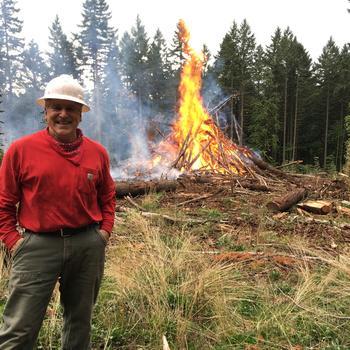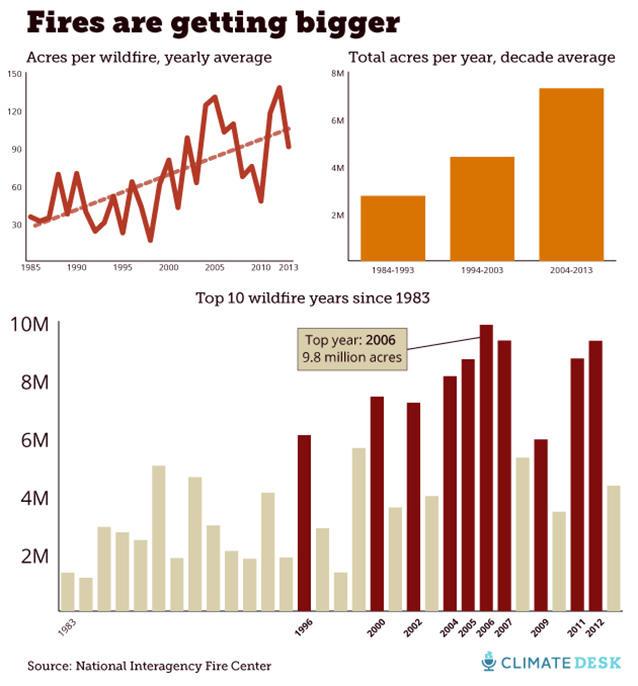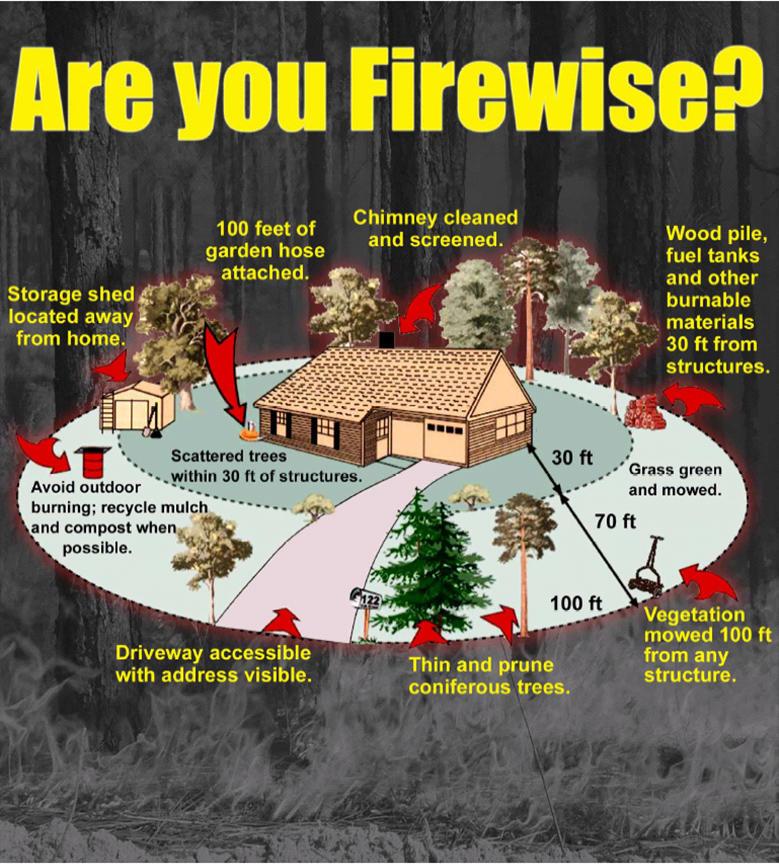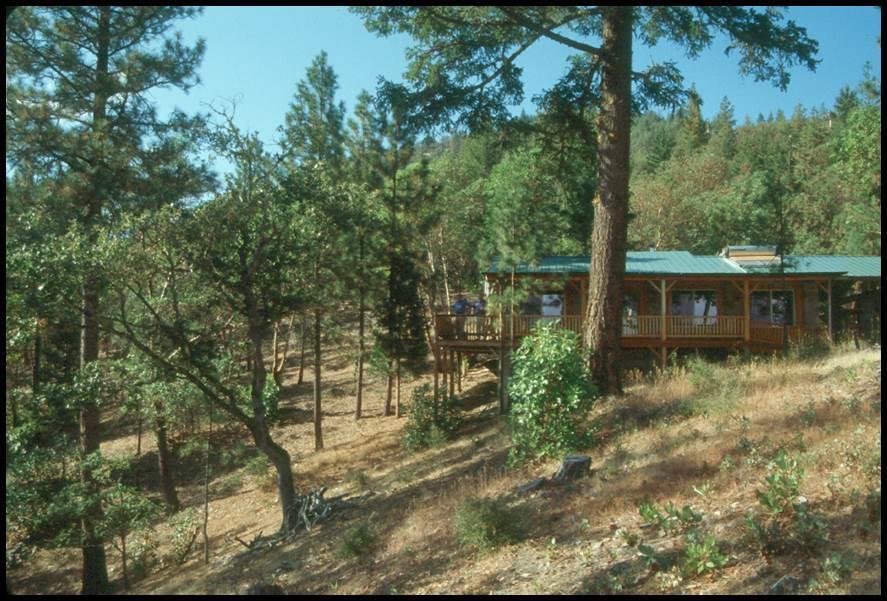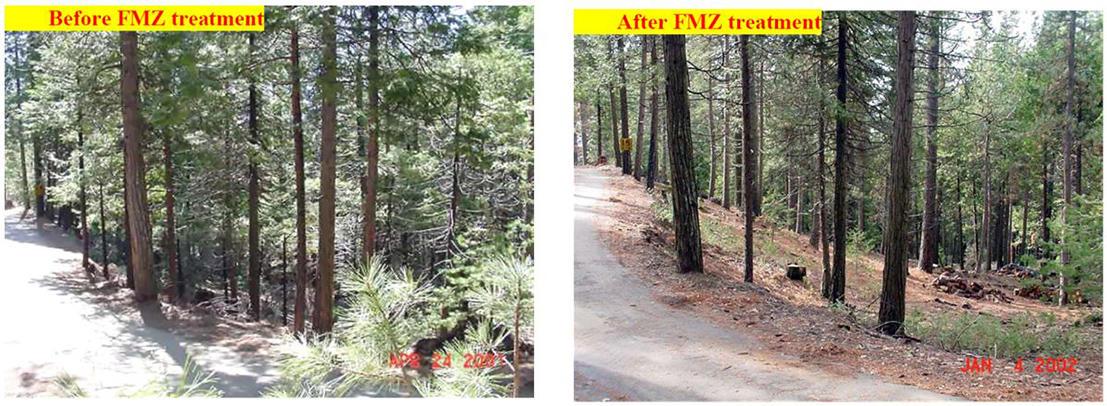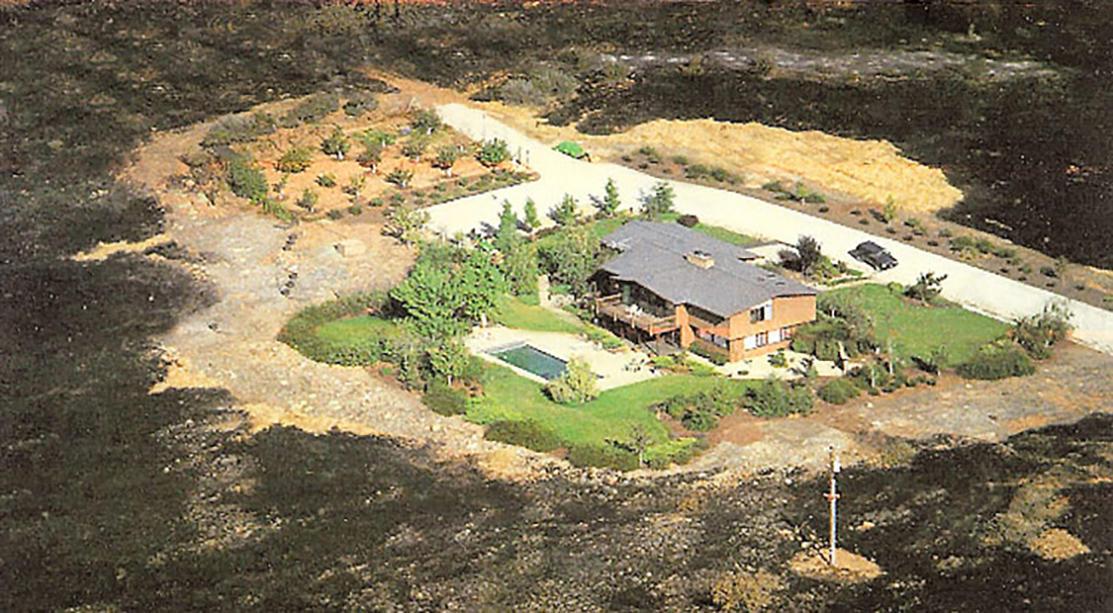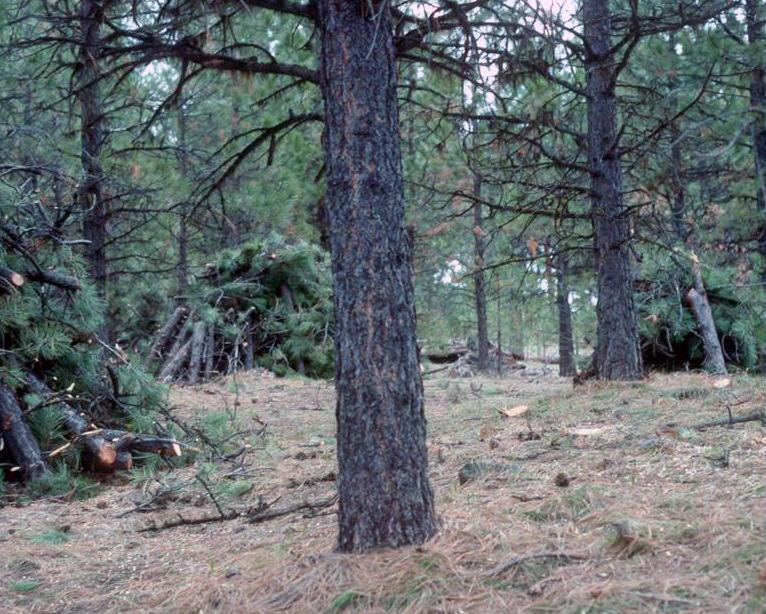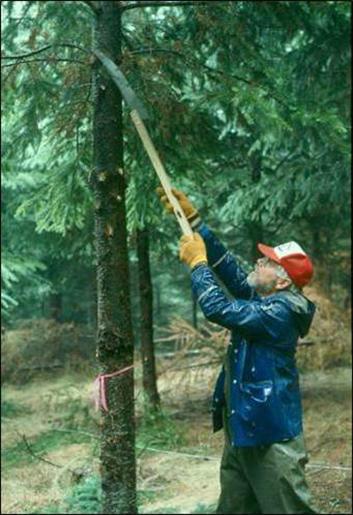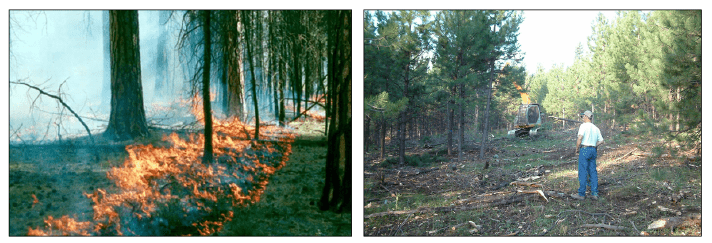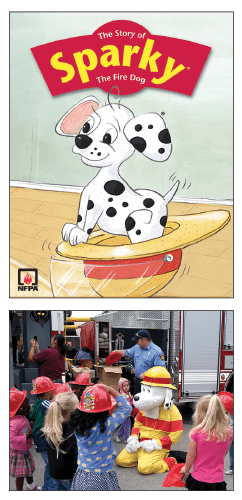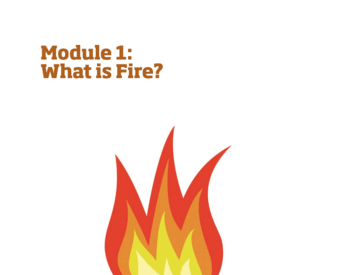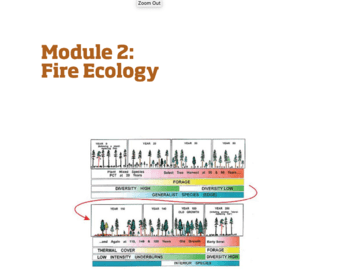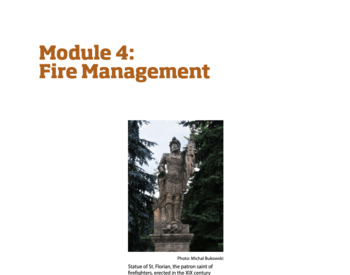Proposed Agendas
Home Ignition Zone
- 9:00-9:15 - Welcome, introductions, and class objectives
- 9:15-9:30 - Historical context for fires and fire facts
- 9:30-10:30 - Risk assessment
- 10:30-10:45 - Break
- 10:45-12:00 - Designing and creating a fire-resistant home
- Noon-12:30 - Lunch
- 12:30-1:00 - Resources available
- 1:00-4:00 - Field tour and hands-on application exercises
Defensible Space
- 9:00-9:15 - Welcome, introductions, and class objectives
- 9:15-10:30 - Defensible space: Getting into the zone
- 10:30-10:45 - Break
- 10:45-12:00 - Defensible space treatments
- Noon-12:30 - Lunch
- 12:30-1:00 - Ready, Set, Go! When disaster strikes
- 1:00-4:00 - Field tour and hands-on application exercises
Overview
This module teaches students how to prevent or minimize fire related losses in and immediately around the home by learning how to recognize fire hazards and take appropriate mitigation strategies.
Learning Objectives
- Understanding home fire risk management and prevention
- Know the risks of flammable or combustible material surrounding home
- Understand management alternatives for minimizing those risks
Learning Outcome
Develop and implement the practices necessary for minimizing fire risks.
Content Outline
- Historical Context for Fires
- Strategies and Tactics
- Risk Assessment
- Resources Available
- Home Ignition Zone (HIZ)
- Defensible space
- Zone 1
- Zone 2
- Zone 3
- Defensible space treatments
- Fuel Treatment Options
- Ready, Set, Go!
- Public Awareness Campaigns: Smokey the Bear and Sparky the Fire Dog
- Public Safety Education
Historical Context for Fires
Over the last 20 years, the frequency and extent of damaging wildfire events have increased dramatically (Figure 1), resulting in the tragic loss of natural resources, homes, and human lives. Between 2002 and 2011, insured losses from wildfire-related events in the United States increased $6.2 billion dollars from the prior 10 years, from $1.7 to an astounding $7.9 billion. In some years thousands of homes were lost due to wildfires, such as in 2003 when nearly 4,000 homes were destroyed in Arizona and California wildfires. Wildfires may be inevitable, but the destruction of homes, ecosystems, and lives is not. The question we face is how can our agencies, first responders, and affected communities minimize the risk of loss?
The answer to that question is that preventing losses within the Wildland-Urban Interface (WUI) requires special attention to the hazards within and surrounding the homes themselves. Consequently, the principal responsibility for managing those hazards falls to the property owners. As one author noted “If we are to prevent extensive home destruction within the WUI, property owners must become engaged, matching their authority over the Home Ignition Zone (HIZ) with the responsibility to create ignition-resistant homes.” (Cohen 2010)
This module will provide students with information, knowledge, tools and guidelines that will assist them in recognizing, reporting, and controlling fire hazards and risks at home and within the landscape. This will help eliminate or reduce the causes of fire, and prevent the loss of life and property by fire within the WUI areas.
- Activity I1 – Personal and professional insights
- Students read Insights from a Wildland Fire Professional
1 See Activities section for details on all activities in this curriculum.
Strategies and Tactics
In recent years, the focus of fire prevention has changed. While the end goal of preventing catastrophic loss of life, property, and natural resources has remained the same, the strategies and tactics involved have been modified. Increasing fuel loads and a warming climate (Figure 2) have made today’s wildland fires harder to control, expensive to suppress, and a threat to the lives of firefighters and civilians. Potential negative wildland fire consequences now involve more than blackened acres and property loss. Now wildland fires often burn with intense heat and erratic fire behavior, severely impacting and even altering ecosystems and communities, challenging their ability to recover, and sometimes claiming human lives.
Parallel to wildland fires, modern home fires burn hotter, are more erratic, and flashover (the sudden involvement of a room or an area in flames from floor to ceiling) faster than homes of the past. Homes now have furniture, carpeting, and materials creating fires that involve hydrocarbon and synthetic-based contents such as foam rubber, nylon, rayon and polypropylene. These fires have a relatively high heat release rate when compared to the natural fiber products found in legacy fires, materials consisting of solid wood, wools, and cottons. Where firefighters could have had 30 minutes to enter a burning building in the past, they now have 2 to 3 minutes before the intense flashover occurs. At that point, the room and all within it are completely destroyed.
Consequently, it is paramount that the ignition risk be minimized. While past suppression tactics have been effective, fire prevention tactics and strategies have changed. We no longer can afford to invest all our resources in fire suppression forces, equipment, and strategies. “Reactive” fire suppression programs must evolve into “proactive” fire management programs. We must effectively apply fire prevention and hazardous fuels reduction techniques that focus on mitigating the susceptibility of structures to the wildfire exposure. Property owners, agencies, and first responders must all work collaboratively to achieve the best results.
A good way for WUI property owners to begin taking responsibility for making their homes safe from wildfire is not to ask if a wildfire will hit their community—but when. The likelihood of a fire and potential severity of consequences leads to the next question: What can I do to minimize my risks? A good overview of the topics that are covered in this module is the OSU Extension publication Before Wildfire Strikes! A Handbook for Homeowners and Communities in Southwest Oregon (EM 9131).
- Activity II – Fact Sheets
- Fire Overview Fact Sheet
- Fires in the United States during 2015 Fact Sheet
Assessing the Risks
Once a property owner recognizes that risks exist and commits to minimizing those risks, the first step is to develop an understanding of what those risks are. We’ll begin with an overview of the rich sources of information available, in particular the abundant Firewise materials that are available online. We will learn about concepts such as the Home Ignition Zone (HIZ) and how to assess the risks to the home by methodically examining construction design and materials used. We’ll also learn about defensible space and how to evaluate the risks of ignition from potential fire fuel sources such as fences, outbuildings, propane tanks, and so on.
There are a variety of excellent resources to begin evaluating your exposure to wildfire risks, including homeowner’s checklists that detail the numerous considerations that need to be examined carefully.
These checklists not only identify the important criteria for creating a fire safe home but also provide suggestions on what to do when a problem is identified. A good example of that is the Defensible Space Planning and Preparation Fire Awareness Checklist which leads the homeowner through everything from road access and availability of water, to a detailed examination of the home and appurtenances (fencing, decks, propane tanks, etc.), to the vegetation surrounding the home. This and other helpful checklists are the Fire Safe Council’s Homeowners Checklist and the Structure Assessment Checklist, which can be found in the Additional Resources section.
If you would like to have professional help with conducting a comprehensive assessment of your property, consult with your local Fire Department, Rural Fire Department, Oregon Department of Forestry office, or other entity responsible for providing fire protection for your community.
- Activity III – Assessing the risks
- Students will review publications and websites listed in the Activities section.
- Students will review, discuss, and apply the Homeowners Checklist and the Fire Awareness Checklist.
- Students will review, discuss, and apply the checklist Defensible Space Planning and Preparation.
- Activity IV – Pre-Plans
- Review and create examples of pre-plans for fire preparedness.
- Activity V – Safety/art
- Students discuss and illustrate fire safety hazards in the home.
Resources for Assistance
While it is essential for each landowner to assess their risks and take proactive steps to minimize those risks, it is helpful to think more broadly about the risks that threaten the whole community. For example, landowners may do everything right to protect their home, but if the neighbors don’t follow suit, all their efforts may be in vain. A Fire-Adapted Community in which all the residents are Firewise requires little assistance from firefighters during a wildfire event. These residents accept their responsibility for living in a fire-prone area and they possess the knowledge and skills to prepare their home and property; evacuate early, safely, and effectively; and most importantly, survive if they become trapped by a wildfire (Figure 3).
It is important to know that there are well-established, proven steps that homeowners can take to improve their personal safety and home survival during a wildfire. Once implemented, especially at the neighborhood level, these recommendations will assist communities in becoming Fire Adapted Communities.
When the area needed to create an effective defensible space exceeds your own property boundaries, you’ll need to contact your neighbors, whether private citizens or government agency entities, to discuss opportunities to work cooperatively. The effectiveness of Defensible Space Zones improves dramatically when entire neighborhoods implement the recommended practices. Before proceeding with efforts to create a Firewise community in your area, always check with your local fire department or fire district to enlist their help. Reducing fire risks through home improvements, vegetation fuels management, or other steps can be expensive. Some landowners may be able to do the work themselves and thereby reduce the costs, but others, lacking the time, skills, or physical ability, may have to use contract services, which can be expensive. Funding through grants or cost-share programs may be available to help offset the costs, but the availability of those resources can vary widely from area to area and from year to year. Check with the appropriate agencies in your area on what may be available and how to apply. Agencies to consider include the Oregon Department of Forestry, USDA Forest Service and the Bureau of Land Management.
- Activity VI – Resources for Assistance
- Have students review the documents and websites listed in the Activities section.
- Students will discuss the resources that are available and how their communities may benefit.
- Students will evaluate their own communities following the suggestions and guidelines within the materials provided in the Activities section.
Home Ignition Zone - HIZ
The two factors that primarily determine whether a home survives a wildfire are its structural ignitability and the effectiveness of the defensible space surrounding it. These two things form the basis for a concept called the Home Ignition Zone or HIZ. Homeowners must recognize and take the steps needed to reduce or eliminate potential fuel and ignition sources within the HIZ which includes flammable vegetation and materials surrounding the home.
While building a noncombustible home can be prohibitively expensive, careful attention to utilizing appropriate construction materials and fuel management on the site around the home can make it possible to construct homes that are resistant to fire on their own, or at least make the job of protecting homes much easier for the homeowners and firefighters.
Selecting the most appropriate construction design and materials requires understanding the nature of the risks of any given site. A homeowner should look at the probable intensity of the fire, or how hot it will burn, and its duration, or how long the fire will burn. If intensity and duration will be low, it may be possible to make the home safe with relatively few precautions. But if intensity and duration risks are high or even extreme, then all possible precautions will have to be considered to create a survivable structure.
A useful way of looking at the risk of fire to your home is comparing fire and water. Just like water, fire will try to find a way into a home. Most parts of the structure can be fire-resistant but a single weak point that allows fire to get in will undo all the other good work. Although wildfires always present significant risk of loss, homeowners and communities that take appropriate precautions can successfully live in fire-prone areas.
- Activity VII – Home Ignition Zone (HIZ)
- Students review “Wildfire: Preventing Home Ignitions, Parts I & II” (videos)
- Students review “FireWise Construction: Site Design & Building Materials”
- Students review and discuss a “Home Ignition Zone Structure Assessment Guide” form
Defensible Space
The general rule regarding the HIZ also applies to Defensible Space. Fire will find the weak link in your home’s protection safeguards. Unmanaged fuels in the defensible space can doom even a superbly built home (Figure 4).
Fire professionals have developed a system for analyzing and managing defensible space. This includes identifying three distinct zones, each with its own treatment goals and prescriptions. (Figure 5)
- Zone 1: The “lean, clean, and green” zone extends 30 feet out from the edges of the structure. This area should not have any continuous fuels that would enable fire to burn up to the structure. This includes wood fences, particularly if a building has flammable siding or other materials. If non-flammable home construction materials are used, then judicious use of “fire-wise” plants can be utilized. Never store combustible materials such as firewood in Zone 1.
- Zone 2: This is an area of fuel reduction extending out 100 feet from the outer edge of Zone 1. The goal in Zone 2 is to reduce a fire’s intensity. Actions within this zone include thinning out trees and shrubs and removing ladder fuels from under the remaining trees. Keeping the grass mowed is critical, especially later in the year when grasses dry out. It’s OK to stack firewood or have other fuels stored in this zone, but keep them at least 30 feet away and uphill from the home.
- Zone 3: Includes everything from the outer edge of Zone 2 to the outer boundary of your property. Treatment recommendations include thinning, pruning, and slash-disposal processes like piling and burning, chipping, or lop-and-scatter.
Annual maintenance of your defensible space is very important. Trees and other vegetation continue to grow, so their fuel hazard “profile” will change and require treatment (Figure 6).
Defensible Space Treatments
Module 3 provides an in-depth review of the factors that affect fire behavior. This section will show how those principles applied to on-the-ground treatments can greatly reduce wildfire risks. Homeowners can use this information to learn how to alter the total amount, composition (sizes), and arrangement of fuels and thus reduce the intensity and severity of a wildfire. No forest is “fire proof” but a properly treated WUI property will have a much higher probability of survival (Figure 7).
There are three types of fires—ground, surface and crown—and a wildfire may have all three. The proportion of each type will determine fire severity damage risk. Ground fires stay close to the ground surface and mostly consume duff (accumulated dried and decomposing vegetation) in a low intensity burn. Lower intensity surface fires consume needles, moss, herbaceous vegetation, shrubs, small trees and saplings and are generally not too harmful. However, high-severity surface fires can kill most of the trees but the impacts can be highly variable from point to point. Crown fires, which are very destructive, occur when enough heat is released in a fire to preheat and combust fuels above the surface leading to active crown fire spread from tree crown to tree crown. Strong winds and steep topography can greatly exacerbate the rate of spread.
The goal for homeowners is to manage their fuels so fire will remain a ground or low-intensity surface fire. The six principles for creating and maintaining a fire-resistant property are:
- Reduce surface fuel quantity
- Increase the spacing of fuels, both structural and vegetative
- Increase the height from the ground to the base of tree crowns
- Increase spacing between tree crowns
- Retain larger trees of more fire-resistant species
- Promote fire-resistant forests at the landscape level
By following these guidelines, fire intensity will be reduced so firefighters will have an easier time fighting the fire and a large part of the landowners’ woodlands will be able to survive a fire.
Fuel Treatment Options
Thinning trees is one of the most powerful forest management tools available, allowing landowners to pursue their goals and objectives by altering stand density, stand structure, and species composition (Figure 8).
In addition to creating healthy, vigorous stands for wildlife habitat, wood production, and aesthetics, thinning decreases wildfire hazards by reducing the quantity and distribution of forest fuels. Leaving larger, more vigorous trees and removing smaller trees reduces the total fuel load, removes the ladder fuels, raises the height to the base of the tree crowns, and increases the spacing between crowns, making it harder for a crown fire to spread.
Pruning tree branches to increase the height to the bottom of the crown may be an additional action conducted at the time of a thinning, or as a stand-alone treatment (Figure 9). Pruning is especially effective in young stands where the shading effect has not yet caused the tree crowns to lift. In general, at least 50 percent of the live crown needs to be retained for good tree growth, but if the trees are tall enough, then a reasonable pruning height is 10 to 12 feet. This amount of separation between the ground and lower branches will increase the fire resistance substantially.
Prescribed burning to reduce surface fuels, especially after treatments like thinning and pruning, is often accomplished by piling and burning the slash within the stands. Piling may be accomplished by hand or by machine and is highly effective for reducing the fuels. Underburning is also effective and can serve other ecological goals such as controlling unwanted vegetation, improving wildlife habitat, increasing species diversity, and releasing nutrients (Figure 10). More people are using prescribed underburning, but it requires a high level of expertise to get the desired results and may expose the landowner to substantial liability if the fire escapes its boundaries and damages neighboring property.
In situations where burning fuels is not an option, mechanically treating the fuels is an effective way to substantially reduce homeowner liability (Figure 10). For example, in stands with light surface fuels, it may be practical to cut small trees, branches, and even brush into smaller pieces and scatter them about the site.
While this practice, called “cut and scatter,” doesn’t get rid of the fuel, it does redistribute it so that a ground fire will not become a threat.
Another method to consider is employing mechanical fuels reduction processes, known as mastication, in which machines are used to grind, chop, crush, or mow fuels, breaking it apart into relatively small pieces and distributing the material across the site. Mastication is an effective tool, but it can be expensive, not suitable for steep terrain, and may result in undesirable soil compaction or damage to desirable trees.
The fuels management requirement is not a “do it and forget it” process. Forests are dynamic systems; trees and brush continuously grow over time, requiring periodic follow-up treatments.
Property owners may want to do fuel management on their property every year in order to spread out the workload and make it more manageable and economically feasible.
- Activity VIII – Defensible Space
- Students will review defensible space videos.
- Class will visit WUI home sites and create management plans for reducing fire risks.
- Activity IX – Defensible Space Treatments
- Students will review Defensible Space Treatments publications in the Activities Section.
- Students will visit WUI home sites and create defensible space management plans to reduce fire risks.
- Activity X – Action steps for around your home
- Students will review the Firewise Toolkit and Have A Firewise Home publications.
- Students will review the Ready website.
- Students will discuss actions their families should to take and create an action plan.
Ready, Set, Go!
Now let’s turn our attention to what to do when a fire comes to your area. As many experts will say, it’s not a matter of if a fire will occur, but when. Just as the primary responsibility for making your home and property fire safe falls to you, the responsibility for protecting yourself, your family, and your property is up to you. And the old adage of “hope for the best but plan for the worst” applies well here. When a wildfire strikes a WUI community, things can happen extremely fast and be extremely chaotic: roads jammed with people leaving and firefighters arriving, visibility reduced by heavy smoke, and a strong sense of panic and fear.
It’s not a good time to be scratching your head trying to figure out what to do. You need to be physically and mentally prepared for such a scenario, and that includes creating and following a sensible evacuation plan.
The checklists included in the Ready, Set, Go! reading for this section provide an excellent basis for planning.
It’s a good idea to review your plans with your local firefighting agency. It would also be a good idea to work with that agency to organize your community into a Firewise Community so that all homeowners create fire-resistant homes and property and their own Ready, Set, Go! checklists.
- Activity XI – Ready, Set, Go!
- Students will review Awbrey Hall Fire, Bend
- Students will review Ready, Set, Go! Your Personal Wildfire Action Plan.
- Students will review Get Ready to Go.
- Students will review Forest Home Fire Safety.
- Students will create and share their own Ready, Set, Go! checklists.
Public Wildfire Awareness Campaigns: Smokey & Sparky
Minimizing the risks to homes, private woodlands, and public forests from wildfire needs everyone’s awareness and participation. However, creating and distributing a message that large numbers of people will hear, understand, and respond to is a bit daunting. Enter two iconic heroes who for nearly 70 years have educated many millions of Americans about the dangers of fire: Smokey Bear and Sparky the Fire Dog.
Origins of the Preventing Wildfire Campaigns
Smokey Bear
Smokey’s history begins with World War II (Figure 11). The spring following Japan’s December 7, 1941 attack on Pearl Harbor, Japanese submarines surfaced near the coast of Santa Barbara, California, and fired shells that exploded on an oil field, very close to the Los Padres National Forest. People feared more attacks that would kill people, destroy property, and ignite wildfires in the forests along the Pacific Coast.
Forest protection became a national concern. Many thought that people could prevent wildfires by being careful. The Forest Service, with the help of the War Advertising Council and the Association of State Foresters, organized the Cooperative Forest Fire Prevention (CFFP) program, which was designed to educate people about wildfire, suggesting that preventing wildfires would help win the war. The CFFP created posters and slogans, including “Forest Fires Aid the Enemy,” and “Our Carelessness, Their Secret Weapon.”
Then in 1942, along came Walt Disney’s wildly popular motion picture, “Bambi” and Disney allowed the CFFP program to use the film’s characters on a 1944 poster. The “Bambi” poster was a success, proving the effectiveness of using an animal as a fire prevention symbol. But, Disney only loaned the characters to the campaign for one year so a new animal face that the CFFP could own and control was needed. What could be more fitting than the majestic, powerful (and cute) bear?
The Orphan Cub
On August 9, 1944 the legendary Smokey Bear was authorized by the Forest Service, and the first poster was delivered on October 10 by artist Albert Staehle. Smokey Bear soon became popular, and his image began appearing on more posters and cards. But Smokey was just an image.
Six years later on a spring day in 1950, in the Capitan Mountains of New Mexico, a major wildfire swept through the forests. As the crews battled to contain the blaze, about 30 of the firefighters were caught directly in the path of the fire storm and barely survived by lying face down on a rockslide for over an hour as the fire burned past them.
As the crew started to leave, they found a little cub that had not fared as well. He climbed a tree that became completely charred, and escaped with his life but with badly burned paws and hind legs. The crew carefully removed the cub from the tree and eventually handed him over to a New Mexico Department of Game and Fish ranger who was able to get the cub on a plane to Santa Fe, where his burns were treated and bandaged (Figure 12).
News about the little bear spread swiftly and soon, United Press International and Associated Press broadcast his story nationwide, striking a chord with many people. The state game warden wrote to the chief of the Forest Service, offering to present the cub to the agency as long as the cub would be dedicated to a conservation and wildfire-prevention publicity program. Smokey Bear was no longer just a made-up character; he was real.
Over the years Smokey Bear’s message has been broadcast to the American public in radio and video ads featuring famous celebrities such as John Wayne, Bing Cosby, Roy Rogers, Jonathan Winters, Ray Charles, and even The Grateful Dead.
The Smokey Bear Wildfire Prevention campaign is now the longest-running, and most effective, public service advertising campaign in U.S. history. Smokey is one of the world’s most recognizable characters, and the “Only You Can Prevent Wildfires” campaign has enjoyed tremendous success. Smokey’s message is still relevant today as wildfire prevention remains one of the most critical issues affecting our country.
Sparky the Fire Dog
Sparky the Fire Dog was created for the National Fire Protection Association (NFPA) in 1951 and has been the organization’s official mascot and spokesdog ever since (Figure 13). Like his friend Smokey, Sparky is a widely recognized fire-safety icon who is beloved by children and adults alike.
Millions have learned about fire safety through educational lessons and materials featuring his image and he is more active than ever today. Sparky frequently visits schools and participates in community events to spread fire safety messages, often accompanied by his firefighter friends.
In addition to connecting with the public through public service announcements and his featured role in Fire Prevention Week campaigns each October, he hosts a very active website.
The NFPA was first formed in 1896 by insurance firms hoping to standardize the new and burgeoning market of fire sprinkler systems. NFPA’s mission is to “help save lives and reduce loss with information, knowledge and passion.” Today it has more than 65,000 members around the world, and the scope of NFPA’s influence has grown from sprinklers and fire extinguishers to include building electrical systems and almost all aspects of building design and construction.
Public Safety Education
Sponsoring a variety of life-saving campaigns and training programs, the NFPA devotes much of its efforts to protecting lives and property through educational outreach programs such as:
- The annual national Fire Prevention Week in October
- Remembering When, a program developed to address the leading causes of injuries and death among older adults
- Risk Watch and Learn Not to Burn, programs developed to address the leading causes of injuries and death among children
- The resources and activities associated with Sparky the Fire Dog, the official mascot of NFPA.
- Fire educators and professionals all know and love Sparky the Fire Dog, and now he has been recognized as one of the country’s top-notch mascots on Madison Avenue’s Advertising Walk of Fame in New York City.
Notes to the Instructor
Room Setup
The facilitator should secure a room large enough to comfortably accommodate the number of participants. Organize the room in a U‐shape fashion with long tables and chairs. The room should have a large screen to display the presentation. There should be a large table up front (6 to 8 feet in length) for the instructor to use for in‐class demonstration(s) and to display various props.
Instruction in the Field
It is recommended that a guest presenter/facilitator from a state or local fire department or agency lead exercises. These hands-on activities can be skipped, if not applicable to the class.
Total Time Needed
Approximately 8 hours in the classroom and 8 hours in the field (including travel time)
Equipment/Materials Needed
- Computer with PowerPoint
- Internet access
- Computer access for students
- Projector and screen handouts
- Flip easels or wall space
Delivery Method(s)
- Presentation from instructors
- In-class demonstrations
- Outdoor demonstrations
- Discussion
- Online with Canvas
Prep/Background
The information within this module is extensive and detailed, and while personal WUI wildfire experience and education would be beneficial for teaching the module, the resource materials such as the Firewise and OSU Extension publications are written for the non-professional audience. Reviewing the materials ahead of class will be helpful to teach confidently. Many of our firefighting agencies are eager to help their constituents better understand how to proactively reduce their wildfire risks and may be able to provide personnel to assist with key parts of the discussion and activities.
The agendas shown on Page 2 are just suggestions. Your audience, class goals and objectives, and time constraints may require a very different approach. The material presented here is merely a tool to help your educational outreach needs, so modify them as needed.
You are strongly encouraged to require students to review selected readings ahead of class so they arrive prepared to discuss. Have students study the assessment checklists for HIZ and Defensible Space and apply them to their own situations before class.
Demonstration Set-up
Many student activity exercises involve using the processes and checklists from the reading materials. For those situations, obtaining help from a qualified professional may provide a more thorough and rigorous educational experience due to the “real-world” knowledge and experience professionals possess.
Handouts
- Each student should receive his or her own binder containing copies of the suggested readings or lists of the websites where other materials such as videos are located. It may not be practical for the students to study all the suggested materials, so the instructor may want to select a few publications or highlight certain sections for review.
- A copy of the PowerPoint presentation (3 slides per page to allow for note taking)
- Other handouts can be downloaded from the section, “Additional Student Resources.”
PowerPoints/Videos
Module 5—Fire Prevention for Home and Landscape—PowerPoint.
Evaluation instrument
In this module, students will take on the role of a firefighter conducting a risk assessment and fire-management plan for an urban community or community in the WUI. Have students use the resources from the activities above to create a risk assessment for a neighborhood in their community. Students will then create a fire management plan (or incident plan) for a fire that hypothetically started in the neighborhood. A final product will include a map of the neighborhood, evacuation routes, areas that might be particularly dangerous for firefighters, the risk assessment, and a written fire-management plan.
Class evaluation— Provide a survey for student feedback for each module as a form of formative evaluation.
Activities
I. Personal and Professional Insights
It was a typical winter in western Montana with lots of snow and cold temperatures going down to minus 15 to 20 degrees each night. We got the dispatch at about 11 pm and raced to the station over ice-slick roads, started up the engines (thank goodness we can plug in our engine heaters in the winter) and drove into the night, glad to have the heavy turnout gear to insulate against the cold. The drive was through the woods and over a couple of miles of backcountry roads with 2 feet of snow on the ground. The Fire Department to the east made it to the cabin fire first and had already deployed their hoses and had a ladder to the roof. Smoke was boiling out of the eaves and the start of a flame was beginning to show out a small attic window. We cut the metal roof out, provided ventilation for the fire to escape, and doused the attic with water. Thank goodness, the electricity had been off before we arrived. The investigation for the fire’s origin and cause started as the crew did the clean-up. We kept the engines running to prevent the water lines from freezing. What we found in the house was unfortunately somewhat typical: the attic had old wiring frayed with age and brittle insulation. As the appliances in the house overloaded the capacity of the wires, the frayed and cracked lines heated up and started to spark and flare. The fire had started along the underside of the roof trusses and was just beginning to heat the contents of the attic and spark below when our hose water hit the heat and cooled everything down. The heat of the chimney on this cold winter night going up through the attic also helped to crack the old insulation of the wires as they passed next to it. Stacks of newspapers and boxes of old papers stuffed into the attic for storage would have created an explosive situation if we hadn’t arrived when we did. The owner had asked us to conduct a landscape assessment for fire risk that past summer. He was worried about wildland fires. We recommended a lot of proactive prevention and to his credit he had reduced a lot of fuel throughout his landscape, pruned up branches, and reduced the risk by creating a defensible space. We didn’t know it at the time, but the inside of the house needed an inspection, too. The wiring should have been replaced, the fuel in the attic should have been removed, and fire alarms should have been installed. The fire that winter did not need to happen.
We got back to the Fire Station at about four that morning. We hung up the frozen hoses, knocked the ice off our gear and cleaned our tools and ourselves just in time to get ready for our day jobs since we were all volunteer firefighters.
Two nights later at two in the morning, we responded to another house fire. This one was right off the highway about three miles from our Station. The Assistant Chief and I raced to the scene ahead of the crew to size up the situation and get a plan together for the soon-to-arrive crews and equipment. When we pulled up to the house, we saw the cold and shivering family of six kids and two adults in the front yard. We bundled them up and put them inside the warm rescue truck that had just arrived on scene. We did our walk-about around the house and saw fire jetting out of the top of the chimney into the frozen night sky. The basement was filling with smoke and flames were beginning to show through the basement window. As the crew and engines pulled up, we set them to putting the chimney fire out—and laying out hoses for the fire burning in the wood furnace in the basement. The Assistant Chief grabbed a fire extinguisher from the first engine, ran downstairs and put out the fire just beginning to burn the floor joists adjacent to the furnace. It was also sparking on a pile of oily rags on the floor. Just three feet from that burning pile was a wall of shelving. On each shelf were stacked can after can of solvents, paints, and other extremely flammable materials. Within minutes, the house would have exploded when the fire burned to that wall. His quick thinking and action prevented that. After the chimney fire was out, we cleaned the firebox of the wood furnace.
Years of creosote had built up inside the furnace and within the chimney. The creosote within the chimney burned so hot when ignited that the walls adjacent to the insulated pipe were too hot to touch. One of these walls was in the bedroom where four young kids had been sleeping a short while ago. The house had fire alarms, but not one was working. By sheer luck, one of the teenagers sleeping in a room in the basement woke up when the smoke started, led the rest of the family outside, and called 911.
An annual cleaning of the furnace and chimney, storage of flammable materials outside the house, and batteries and tests for the fire alarms all could have prevented this one, too.
II. Fact Sheet Reading
Use the Fire Facts sheets (below). Use the following questions to check students’ comprehension of the information contained in the fact sheets. (Answers are shown in parentheses.)
- What is the leading cause of home fires? (Cooking)
- How often does a fire department somewhere in the United States respond to a fire? (every 23 seconds)
- Who is more likely to die in a home fire? Young children or older adults? (Older adults)
- What is the leading cause of home fire deaths? (smoking)
- How many civilians died in home fires in the United States in 2015? (3,280)
- What percent of home fire fatalities occurred in homes with no functioning smoke alarms? (3 in 5 or 60 percent)
- Fire departments in the United States respond to a home about every 86 seconds. Use that information to figure out the answers to these questions: How many home fires do U.S. firefighters respond to every hour? (about 42) Every day? (about 1,008) Every month? (about 30,240) Every year? (about 367,920)
- Fire Overview Fact Sheet
- Fires in the United States during 2015 Fact Sheet
III. Assessing the Risks
Students will review:
- Firewise Communities website.
- A Guide to Firewise Principles: PDF.
- The Wildland-Urban Interface Fire Problem. PDF. Cohen 2010.
- Vulnerabilities of Buildings to Wildfire Exposures. S. Quaries. eXtension
- The Basics of Defensible Space and the “home ignition zone.”
- YouTube video Carpenter 1 Fire Defensible Space.
- Wildfire is Coming. Are You Ready to Go! PDF.
Students will review, discuss, and apply the Homeowners Checklist Tips and the Fire Awareness Checklist as a class exercise.
Students may optionally review, discuss, and apply the checklist Defensible Space Planning and Preparation as a class exercise.
IV. Pre-Plans
- Following are examples of fire preparedness pre-planning checklists.
- Students can fill these out based on their recollection of the property and landscapes in which they live.
- Another exercise can be to lead the class to different subdivisions in town—or to various homes in the WUI, break into groups, and complete risk assessments.
- Come together at the end of the session and present and compare ratings.
- Farm Fire Pre-Plan Data Sheet PDF
- Sparky the Fire Dog: My Fire Inspection Checklist PDF
- Sparky the Fire Dog: My Home Fire Escape Plan PDF.
- National Fire Protection Association, Emergency Preparedness.
V. Safety/Art
- Talk about fire safety hazards in the home.
- Make a list of hazards.
- Invite students to draw a cutaway picture of a home that shows a living room, a kitchen, a bathroom, and a bedroom. The illustration should include at least 10 fire hazards for others to identify. Hazards might include a T-shirt tossed over a lamp; a lit candle near a window; a hair dryer teetering on the edge of a sink full of water; a towel close to a space heater; an adult smoking as he lies down on the couch; a frying pan on the stove with the handle pointing outward (a small child nearby); newspapers close to the fireplace; too many electrical cords plugged into one outlet; a smoke detector hanging loosely from the ceiling; a lit cigarette in an unattended ashtray; and a lighter left on a table, to name just a few!
- Once complete, students should exchange illustrations and list the fire hazards in the picture they receive.
VI. Resources for Assistance
Students will review:
- Fire Adapted Communities: The Next Step in Wildfire Preparedness in Klamath County. PDF
- Firewise Communities/USA Recognition Program: PDF.
- USDA Forest Service Community Assistance Grants.
- Community Fire Protection Road Map. PDF.
- BLM OR-WA WUI Fuels Reduction Grants.
- Students will discuss the resources that are available to them and how their communities could benefit from them.
- Students will evaluate their own communities and discuss where improvements might be made and how they as individuals can help the community to accomplish those improvements.
VII. Home Ignition Zone - HIZ
Students will review:
- Wildfire: preventing home ignitions, Parts I & II.
- FireWise Construction: Site Design & Building Materials. PDF.
- Home Ignition Zone: Assessment Details PDF.
- Home Ignition Zone Structure Assessment Guide PDF.
- Students review, discuss, and apply a Wildfire Hazard Assessment Checklist PDF.
VIII. Defensible Space
Students will review:
- Wildfire is Coming… Are You Ready? PDF.
- Carpenter 1 Fire Defensible space (video).
- Creating Defensible Space (video).
- Fire behavior in The Wildland/Urban interface (video).
- Benton County Hazard Rating form PDF.
Class will visit WUI home sites and create management plans for reducing fire risks.
IX. Defensible Space Treatments
Students will review:
- Firewise Guide to Landscape and Construction. PDF.
- A Land Manager’s Guide for Creating Fire-Resistant Forests (EM 9087).
- Reducing Hazardous Fuels on Woodland Property: Thinning (EC 1573).
- Reducing Hazardous Fuels on Woodland Property: Mechanical Treatments (EC 1575).
- Reducing Hazardous Fuels on Woodland Property: Pruning (EC 1576).
- Reducing Hazardous Fuels on Woodland Property: Disposing of Woody Material (EC1574).
- Fire Resistant Plants for Home and Landscapes: Selecting plants that may reduce your risk from wildfire (PNW 590).
- Not all Fires Are Wild: Understanding Fire and Its use as a Management Tool (EM 9114).
Students will visit WUI home sites and create defensible space management plans to reduce fire risks using the techniques described in the readings.
X. Action Steps for Around your Home
- Students will review the Firewise Toolkit PDF and Have A Firewise Home PDF publications.
- Students will review the Ready website.
- Students will discuss actions their families should take and create an action plan.
XI. Ready, Set, Go!
- Students will review Awbrey Hall Fire, Bend.
- Students will review How to Get Firewise by Firewise Madera County.
- Students will review Ready, Set, Go! Your Personal Wildfire Action Plan.
- Students will review Get Ready to Go.
- Students will review Home Fire Safety.
- Create their own checklists using the Ready, Set, Go! suggested guidelines.
- Share and discuss their checklists with the rest of the class.
- Share and discuss their preparations, including working with relevant fire-fighting agencies
Assessment of Knowledge Gained
(Questions and Answers)
- Modern homes tend to burn faster than older homes. How much time do firefighters have after entering a home before a flashover occurs?
Answer: 2–3 minutes
- What are the two factors that primarily determine whether your home survives a wildfire?
Answer: Structural ignitability and effectiveness of defensible space management.
- How far do each of the three defensible zones extend from the home?
Answer: Zone 1, 30 feet; Zone 2, 100 feet; Zone 3, from outer edge of Zone 2 to property boundary.
- What are the five principles for creating and maintaining a fire-resistant property?
Answer: Reduce surface fuel quantity; increase the spacing of fuels, both structural and vegetative; increase the height from the ground to the base of tree crowns; increase spacing between tree crowns; retain larger trees of more fire-resistant species; promote fire-resistant forests at the landscape level.
- What should homeowners do to be prepared for when a wildfire strikes?
Answer: Complete a Ready, Set, Go! checklist.
- What famous character was used in the first public outreach fire prevention campaigns in the 1940s?
Answer: Bambi.
Additional Resources
Agency Contact Information
Checklists
Glossary of Terms
- Firewise Communities: Firewise is a national program that emphasizes community involvement and provides important information for residents to reduce the risk of wildland fire igniting homes. NFPA’s Firewise Communities Program encourages local solutions for safety by involving homeowners in taking individual responsibility for preparing their homes from the risk of wildfire.
- Fire Adapted Communities: A Fire Adapted Community takes responsibility for its wildfire risk. Actions address resident safety, homes, neighborhoods, businesses and infrastructure, forests, parks, open spaces, and other community assets. The more actions a community takes, the more fire adapted it becomes.
- Flashover: Flashover by definition is “the sudden involvement of a room or an area in flames from floor to ceiling caused by thermal radiation feedback.” Thermal radiation feedback is the energy of the fire being radiated back to the contents of the room from the walls, floor, and ceiling. This radiation of energy to the contents of the room will raise ALL the contents to their ignition temperature. When the contents of the room suddenly and simultaneously ignite, this is flashover.
References:
All websites accessed June 8, 2017 unless otherwise noted.
- Activity X - Action Steps Around the Home.
- Awbrey Hall Fire, Bend, Oregon.
- Basics of Defensible Space and the “home ignition zone.”
- BLM OR-WA WUI Fuels Reduction Grants.
- Carpenter 1 Fire Defensible Space YouTube Video.
- Cohen, Jack. 2010. The Wildland-Urban Interface Fire Problem. Fremontia. Volume 38:2/38:3
- Creating Defensible Space (video).
- Defensible Space Planning and Preparation checklist.
- Fire behavior in the wildland/urban interface (video).
- Fire Safe Council’s Homeowner Checklist.
- Firewise Communities.
- Fire Safe Council’s Structure Assessment Checklist.
- Flashover definition.
- Homeowners Awareness Checklist.
- Homeowners Checklist Tips.
- How to Get Firewise by Firewise Madera County.
- National Fire Protection Association, Emergency Preparedness.
- Quarles, Stephen PhD 2012. Vulnerabilities of Buildings to Wildfire Exposures. eXtension. 2012.
- Ready website.
- Smokey Bear.
- Sparky the Fire Dog.
- U.S. Forest Service Community Assistance Grants.
- Wildfire: preventing home ignitions, Parts I & II.


